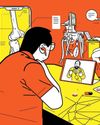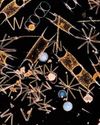
British alcohol company Diageo’s iconic whisky brand Johnnie Walker is preparing to launch its Black Label origin series in India. The series includes four blended whiskies, each honouring the four different whisky regions of Scotland, and includes 12-year-old blended scotch whiskies and single malts from some of the world’s most famous distilleries. Ewan Gunn, Diageo Global Whisky Master, talks to Forbes India about Scotland’s famed whisky-producing regions, their natural differences, and how these differences reflect in the nuances of its blends.
Q What are the natural elements of scotland that add to the flavour of whisky?
Scotland is naturally suited to making the world’s favourite whisky. Our temperate climate and considerable annual rainfall ensure perfect conditions for distilling, and sufficient quantities of pure water with which to make whisky. The climate and landscape also allow us to grow barley, which is one of the raw materials used in Scotch whisky-making. Finally, the peat (which we dig from the ground in Scotland and burn under the barley to impart the smokiness to some of our whiskies) is a key flavour-creating element. We should never forget the people of Scotland either: Generations of skilled craftsmen and women have helped grow Scotch whisky into the most admired and loved whisky in the world.
Q Which are the whisky-producing regions in scotland, and what are the differences in the natural elements of these regions?
Denne historien er fra August 14, 2020-utgaven av Forbes India.
Start din 7-dagers gratis prøveperiode på Magzter GOLD for å få tilgang til tusenvis av utvalgte premiumhistorier og 9000+ magasiner og aviser.
Allerede abonnent ? Logg på
Denne historien er fra August 14, 2020-utgaven av Forbes India.
Start din 7-dagers gratis prøveperiode på Magzter GOLD for å få tilgang til tusenvis av utvalgte premiumhistorier og 9000+ magasiner og aviser.
Allerede abonnent? Logg på

Home-Cooked Meal Is Now Greatly Valued
The pandemic has also brought with it an improved focus on hygiene, use of technology in dining, rise of cloud kitchens and resurgence in popularity of Indian ingredients

Paytm 3.0 - Reaching Near Breakeven In Two Years
As of 2020, Vijay Shekhar Sharma’s super app for financial services had run up losses in thousands of crores. Now, as digital payments gets yet another boost courtesy Covid-19, he’s hopeful of reaching near breakeven in two years

THE PANDEMIC HAS CAUSED WOMEN GREATER LABOUR PAIN
Covid-19 has shown that women are more likely to face the brunt of job losses than men, and find fewer opportunities when they want to resume. That apart, several have to deal with increased hours of unpaid work at home and even domestic abuse

LEADERSHIP WILL BE ABOUT SEEING THE BIGGER PICTURE
Leaders must not only guard their teams first during a crisis, but also deal with stakeholders with respect and dignity. And apart from pursuing business goals, they should remain committed to our planet and the environment

PHILANTHROPY SHOULD BE HUMBLE, BUT NOT MODEST
Apart from building a flexible and resilient framework for the future, philanthropists, civil society and the government must work in tandem so that every rupee is absorbed on the ground

INTEGRATED HEALTH CARE, TECH WILL DISRUPT SECTOR
While clinical research will get a boost, having a skilled workforce and public spending on health care will be challenges in the near term

DIGITALISATION WILL HELP IN VALUE CREATION
As the pandemic brings technology and innovation to the core of business and daily life, the next decade will see about 150 million digital-first families in India

Industry 4.0: Climate Revolution?
Augmenting sustainability alongside digital capabilities is an economic, competitive and global opportunity for India’s businesses, but regulations need to reflect intent

EV Dream Still Miles Away
Electric vehicles have remained a buzzword in India for years. But not much has moved on ground due to high upfront costs, range anxiety and charging infrastructure

Living Waters
A virus has caused us to scramble for oxygen but our chokehold on the environment is slowly strangling the very waters that breathe life into us. The virus is a timely reminder: We are merely consumers, not producers of life’s breath on this planet